Pancake pans: what are there and how to choose them?

Pancakes are a favorite dish for many generations. Almost every family has their own recipe for pancakes. But ideal recipes do not help someone: pancakes still turn out thick, stick to the pan, burn. Most likely, it’s just a frying pan, so it’s time to buy a pancake maker that will solve the problem of imperfect pancakes.

Features and requirements
Three conditions under which pancakes will always turn out tasty and aesthetically pleasing are the quality of the dough, the quality of the frying pan, and good maintenance of the utensils. The last two points are unambiguously important. Therefore, for frying pancakes, it makes sense to buy a separate pan and not cook anything else on it. If you use the product from time to time for cooking meat or vegetables, it will become unusable in a short time.
The material of manufacture, the shape and size of the pancake pans may differ, but all have common characteristics. All crepe makers have low sides, so the chef easily turns the pancake over (it is the high sides that often interfere with turning over, which makes the pancakes not perfect).
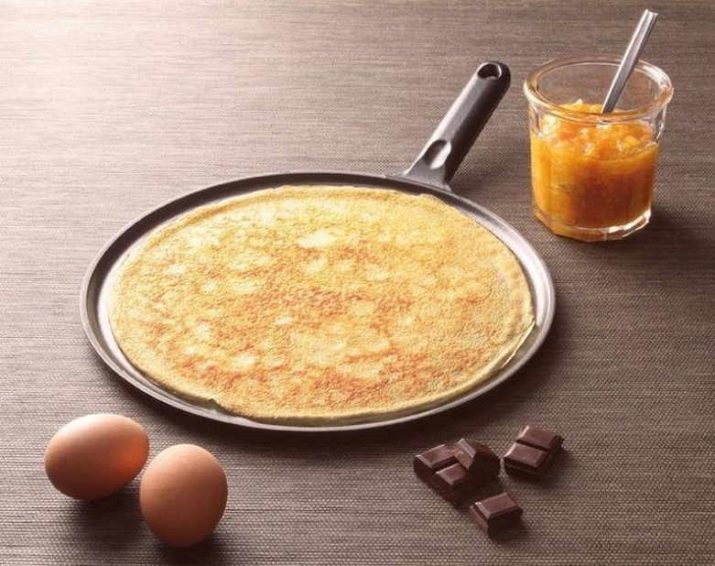
The next feature of a pancake pan is a thick bottom and thick walls. This design gives the utensils special strength and durability. Thanks to the thick sides and bottom, the dishes are easier to adapt to temperature extremes. Cold dough is poured onto a hot frying pan, so the temperature adaptation should be good.
The handle of the pancake maker should be long and not heated, which will allow the chef to cook comfortably. But the round shape of the pancake pan is not its integral feature.If you buy a square pancake maker, you can bake pancakes that are very convenient to wrap the filling.

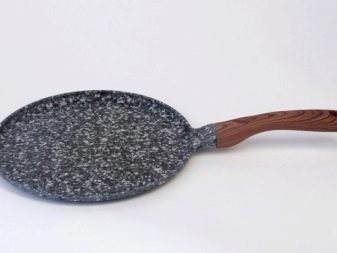
Comparison with a regular frying pan
There are housewives who cannot be given a frying pan, their pancakes always turn out to be successful, and in an hour they bake a whole mountain of flour pleasure. But not everyone can boast of such a culinary gift. Therefore, you should rely on a technically competent approach to baking pancakes: the right pan is half the battle.
What is the difference between a frying pan for frying pancakes and a regular one?
- It is not universal. You won't use it to make your morning scrambled eggs, hearty omelet, or crispy potatoes. The only thing it is for is frying pancakes.
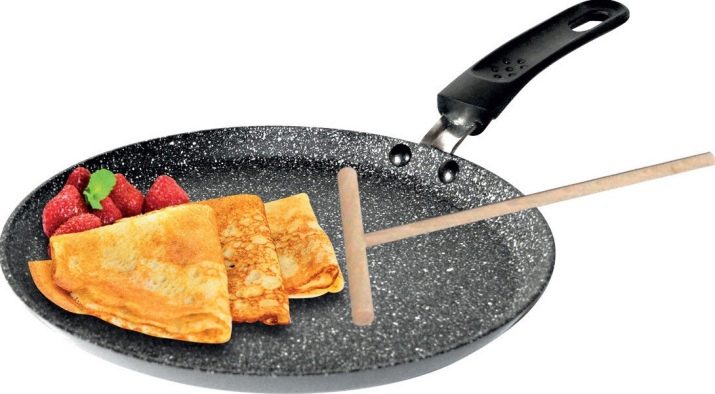
- It has low sides. In some models, the sides are so low that they seem to be almost nonexistent. If you have seen professional crepe makers, then you can note their perfectly smooth round surface, more like a turntable than a frying pan. The dough is rolled out over the surface, it grasps instantly. It is very easy to turn such a pancake.
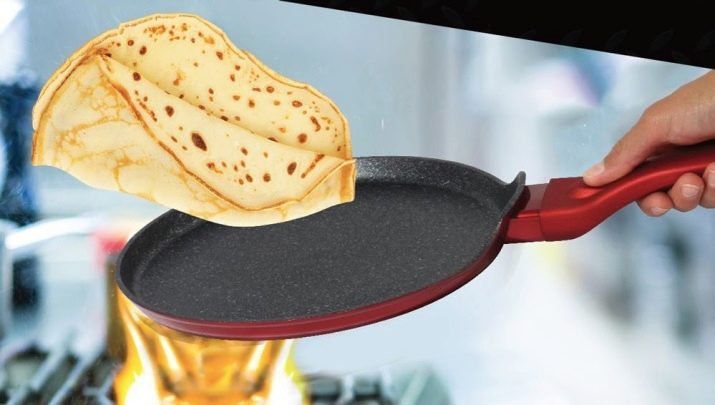
- Comfortable handle. Be sure to pay attention to the handle when choosing your pancake pan. If it is short, fragile, wobbly, you will not be comfortable working with such utensils. The handle should adhere well to the base, be light enough and not heat up much.

- Portion content. You can see pancake makers in stores. These are pans that have round grooves at the base for filling with dough. There can be 4 such indentations in one frying pan. Pancakes in such a frying pan are small, but perfectly smooth.
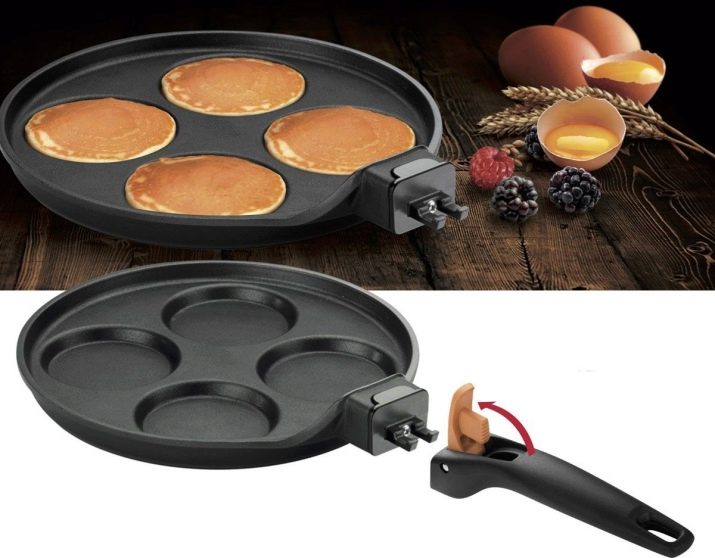
Pancake makers usually don't have lids. There is no need for them, but you can always find a suitable size if you suddenly need it.
Materials and design
The selection of crepe makers today is very large: there are ceramic and marble coated, aluminum and cast iron. To say which is better is objectively difficult - they need a detailed description.
Teflon coated
The coating of such a product is non-stick and should be ideal for baking pancakes. The main thing about this dish is that the pan allows you to bake without oil (or literally with a drop of oil). Dishes are inexpensive, sold everywhere.
But Teflon pans have a significant disadvantage - they require very careful handling. If the surface is scratched, there is a risk of significantly reducing the life of the product. Teflon which is deformed when heated can release toxic substances. But not only deformed Teflon is dangerous: if you heat a Teflon pan above 220 degrees, overheating is also fraught with a toxic reaction.
Therefore, modern Teflon products are equipped with thermal spots - temperature indicators that warn of overheating.
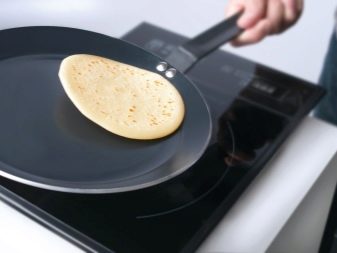
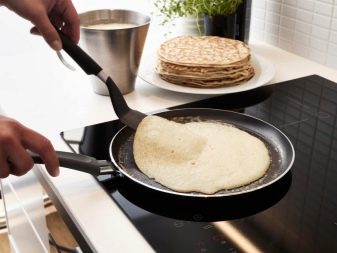
Ceramic coated
Cast iron and aluminum can be the base of a frying pan, but they are covered with ceramics, which gives the utensil the right to be called pottery. Since it beats Teflon in quality, the price of such utensils will be higher. A huge plus of the ceramic pancake maker is that it is not afraid of high temperatures. And it is also safe for human health - ceramics is environmentally friendly (it contains only stone, water, sand), toxic emissions during overheating are excluded.

Before using the ceramic frying pan, rinse it with water, wipe it dry, put it on fire, pour in a drop of oil. The coating will very soon be saturated with oil, and after a couple of minutes you will be able to fry the pancakes in a new frying pan.

Marble coated
Such pans are in trend today - a beautiful spraying, somewhat reminiscent of space pictures, looks very modern.
The advantages of such utensils:
- pancakes do not stick to it and do not burn;
- the composition of the coating is environmentally friendly;
- the "stone" frying pan does not emit toxins;
- the dishes are not afraid of high temperatures.
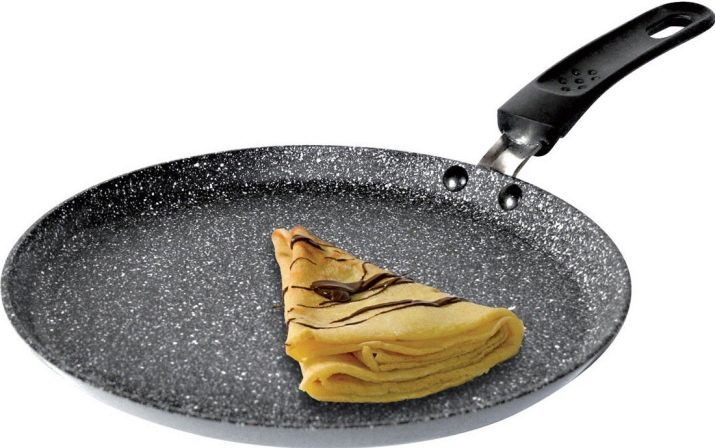
But there were some drawbacks - a marble frying pan is more expensive than a Teflon and ceramic one. But the marble-coated product, according to the manufacturer, will last longer than its cheaper counterparts. She is not afraid of metal shovels and knives, which simplifies the handling of dishes. Still, you shouldn't give her extreme checks: use silicone and wooden spatulas as basic tools for turning pancakes.
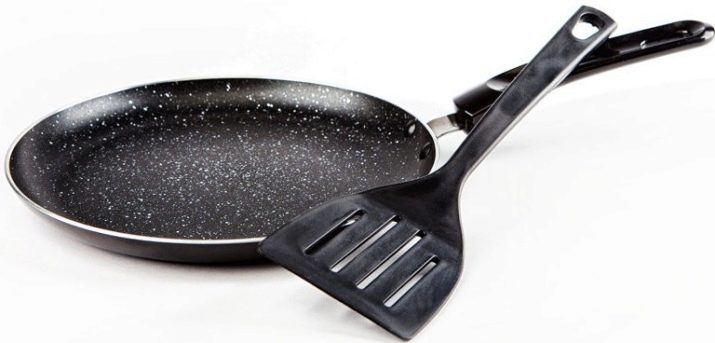
Cast iron
Ideal for conservatives. People began to use cast iron many centuries ago. This material is versatile and time-tested. In terms of durability and strength, hardly anything can compare with it.
The cast iron pan does not have a special non-stick coating, but if you pour oil into it, the material itself becomes non-stick. The longer the cast-iron frying pan has served, the tastier the pancakes will turn out on it - such is the kitchen paradox. But an ideal cast-iron frying pan can be called only on the condition that you don’t fry anything else on it. It absorbs odors well, and pancakes after other dishes cooked on cast iron will taste a little strange.
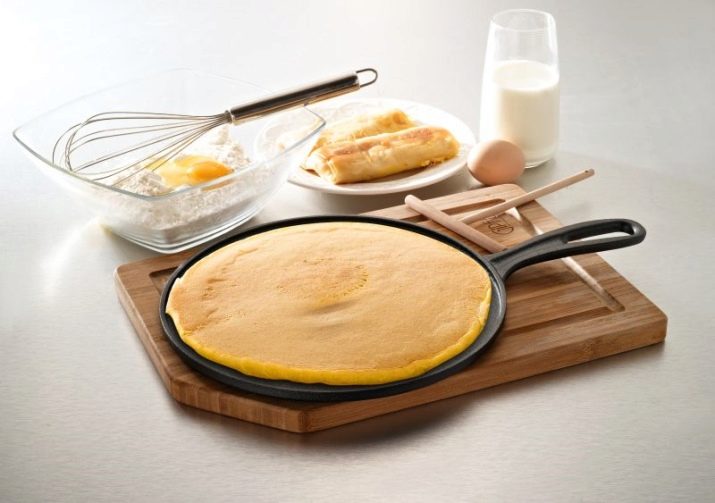
You cannot scratch the cast iron coating. Such a frying pan is durable, strong, easy to clean and hardly deformed. Every second housewife has a frying pan "from mom or grandmother." These dishes are indeed often inherited. It is noteworthy that such utensils are relatively inexpensive.
Cast iron has two drawbacks: it is prone to rust (therefore, you cannot leave the utensils wet) and heavy. If you just bought a cast iron skillet, heat the salt on it until it darkens. Salt takes away fumes, as well as oily substances that were used in the manufacture of cast iron cookware. Repeat the incineration with salt several times. Then you can start making pancakes.
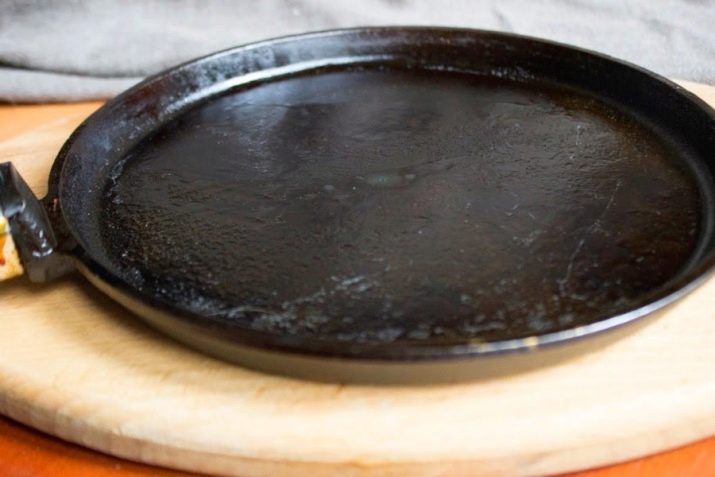
Copper
Copper is a valuable metal that is also used in the manufacture of kitchen utensils. But you can buy such a pancake maker only if you are ready to part with a large sum for the sake of a beautiful acquisition: copper pans are very expensive. Copper utensils warm up well, keep warm for a long time, look beautiful in the interior of the kitchen.
Those who cooked pancakes in a copper pan say that their taste is more refined and subtle. This may be a placebo effect, but it is possible that the noble metal really affects the taste of food.
True, even expensive copper dishes are not without flaws: their surface darkens over time, which does not look very nice.
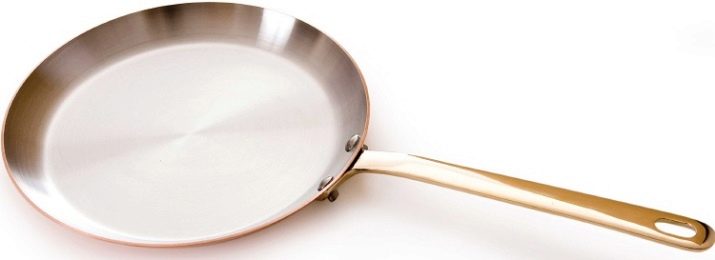
Electric
An interesting option for those who keep up with the times. Crepe makers are flat pans with indentations that allow you to bake perfectly smooth pancakes very quickly. One such electric pancake maker can hold from 2 to 8 slots. Pancakes baked in this way do not stick or burn.

The dough is spread over the frying surface using a special spatula. Most models have a heating temperature selection function. It is noteworthy that more and more manufacturers of such products are producing electric pancakes with removable surfaces: they can change the shape and size of pancakes, make them textured, with a pattern, etc.

Submersible
This adaptation makes life much easier for housewives, who are not only lumpy at the first pancake, but all subsequent ones do not want to succeed. First you need to knead the dough (without deviating from the recipe), then you should turn on the submersible convex pancake maker in the power grid. The heating indicator will inform you in a couple of minutes that you can start baking. The pancake maker should be dipped directly into the container with the dough for literally 2-3 seconds (for thicker pancakes - by 5-6 seconds). After a minute, the first pancake can be removed from the surface.
If the pancakes need golden brown, turn the pancake over and keep it on the surface for 10 seconds. It can only be turned over with silicone spatulas. When everything is ready, the pancake maker is disconnected from the power supply, cooled and wiped with a damp cloth.
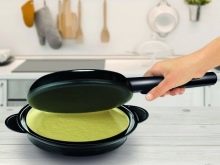
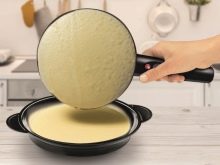
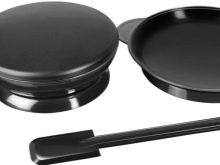
Double-sided
In their structure, such pans are somewhat reminiscent of a waffle iron. They rather resemble a small electric stove than a frying pan. The two dough grooves help to make the pancakes the same size and give them even edges.
Crepe makers with interchangeable surfaces are in great demand: so you decide whether to bake two large pancakes or six small ones. Children really like pancakes with a picture - be it an unpretentious smiley or a bunny. You can also bake pancakes with an interesting texture.
Such a double-sided frying pan is not very cheap.

Shapes and sizes
There is no one size fits all: if you like filled pancakes, you need a large frying pan, up to 30 cm in diameter. It is easy to put the filling into such pancakes and twist them into tubes or envelopes. If you do not fill all the pancakes, then a diameter of 20, 22, 24 cm is quite a suitable size for a frying pan. Very small pancakes are purchased by those who love miniature pancakes.


Square products for pancakes even scare some customers - they can't fit in their heads, how can you make non-round pancakes. Yes, it is originally round, this is the standard. But many have probably noticed that it is very convenient to wrap the filling in pancake squares. In this case, they produce square pans, which are also functional.

Curly pancakes cannot be called unclaimed. Cute kitchen utensils in the form of piglet faces, daisies or droplets are a good option for a family with small children.
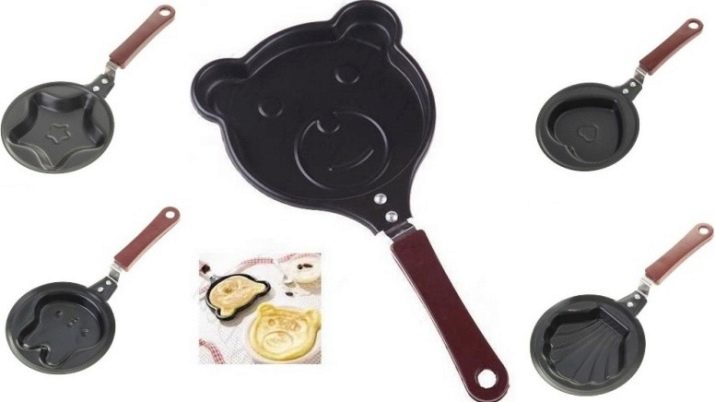
Criterias of choice
The main criteria for choosing a pancake pan are as follows.
- The bottom should be thick and smooth. If the frying pan is very "thin", its rather controversial strength is unlikely to guarantee long-term use. Uniform heating and heat transfer are due to the thick and smooth bottom.
- Low sides. It is very difficult to flip pancakes in a high-sided skillet.
- Non-heating handle... If you purchased a product with a removable handle, the material from which it is made may begin to melt at high temperatures.
- Diameter. It can be less than 20 cm, then the pancakes will be compact. If you like huge pancakes that will fit any filling, buy a frying pan 26-30 cm in diameter.
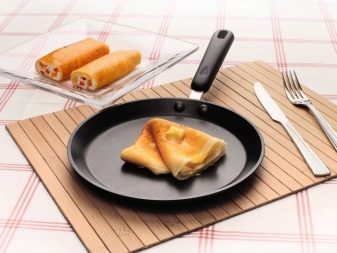
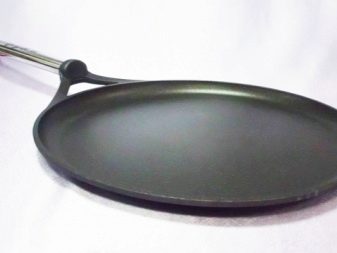
Often the buyer does not delve into the specifics of the purchased product: if you like the frying pan outwardly, like its price, then there will be a purchase. And when the pancake maker fails after a couple of weeks, the buyer is outraged. It is important to know what kind of frying pan is ready to become a "resident" of your kitchen, how to handle it. If it is Teflon, you must provide the product with the most delicate care: when such a coating is deformed, the pancakes will stick and burn.
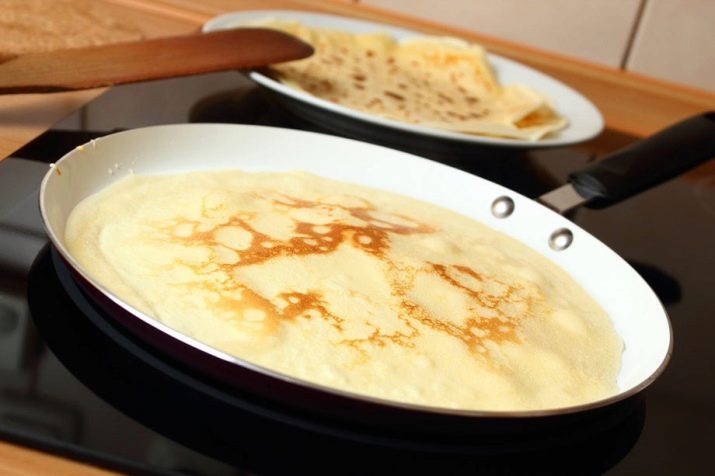
Care Tips
After the mountain of ruddy pancakes is on the table, some housewives rush to put the frying pan in the sink and fill it with water. You can't do that. The pancake maker should cool down on its own, only after that it can be washed. But leaving the pan on the stove for several hours is also not worth it.
Take care of both the base and the handle. Wash the utensils and wipe dry, and only in this form put them in place. Be sure to wash and wipe down the paddles you use to turn the pancakes. It's great if there is a separate scapula for this. Very often, pancake pans are sold complete with spatulas.
Metal accessories are actually not used: cast iron is not afraid of them, but many other materials are afraid, because housewives prefer silicone and wood.
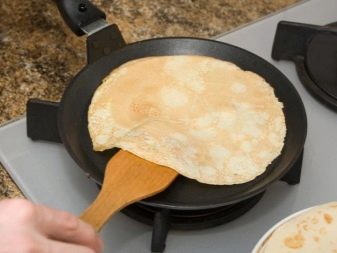

If you bake mocha pancakes, cook the mocha itself in another pan. Do not use the pancake maker for other dishes.
Having bought a new product for making pancakes, carefully read the instructions for it. Do not break it, wash and dry the pancake maker in a timely manner, then you will not have to go to the next pan for pancakes soon.
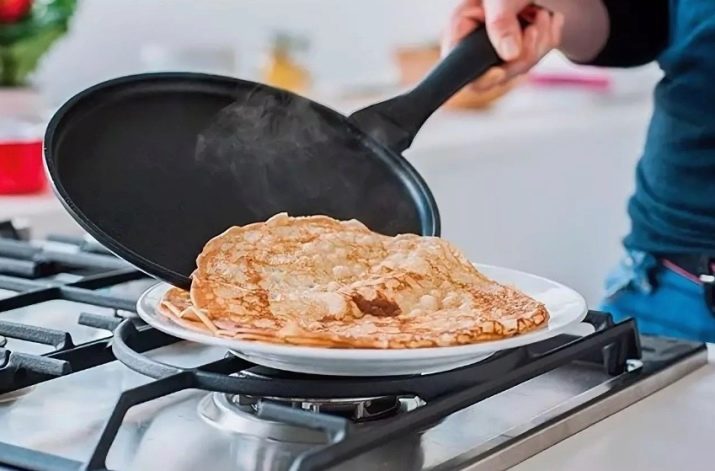
For tips on choosing a cast iron pan for crepes, see the following video.








